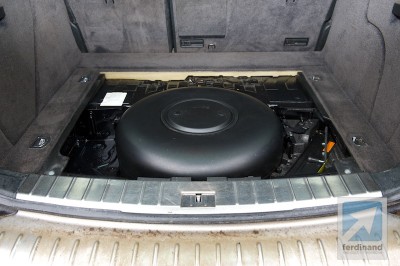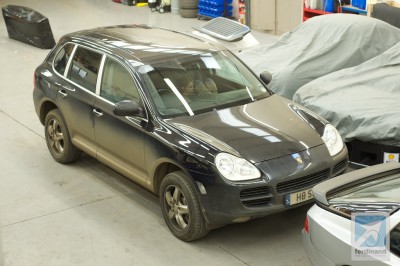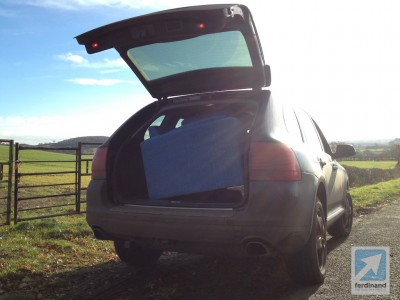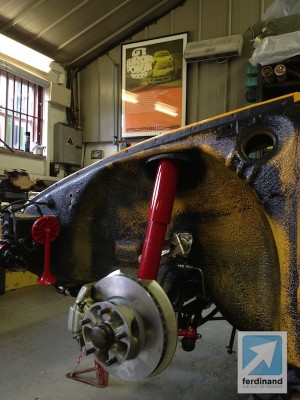
by John Glynn | Jan 28, 2014 | Classic Porsche Blog, Porsche News
We’re familiar with pictures of Ferdinand Porsche in dark hat and overcoat, or in three-piece tweeds, looking through a wheel. These senior pics have kindled a soft, shed-tinkering grandfather image. But here’s a pic you might not have seen before, which proves he was once a young thruster, keen to get ahead.

Now, the Porsche Museum has rescued the vehicle he designed for his success: the Egger-Lohner C2 Phaeton. This first-ever Porsche design has been brought back to Stuttgart and will be officially unveiled on January 31st: the museum’s fifth birthday.


Ferdinand Porsche P1
Porsche called it the P1 (Porsche 1), engraving the designation into its main components (below). As with so much of Ferdinand’s early work, it was powered by electricity, with a compact drivetrain weighing just 130 kilograms. This 1898 vehicle had a range of up to 50 miles, with a switchable body for summer and winter. Excellent!

In 1899, Porsche raced his creation at the international vehicle exhibition in Berlin: centre of the motoring universe. Over a 25-mile course and with three passengers on board, Porsche drove his own P1 to victory, 18 minutes ahead of his nearest competitor. The man was a proper legend.

Porsche is presenting the P1 as a historical artefact, prefacing Porsche’s early commissions and his later work. No over-restoration and no recreations: kudos to them for making it so. I urge you to visit Stuttgart and learn more about Ferdinand and the P1 at the Porsche Museum. Entry is free all weekend over Feb 1st and 2nd.

by John Glynn | Jan 15, 2014 | Porsche Cayenne, Project Cars
I keep in touch with Steve Bennett at 911 & Porsche World magazine, and we’ve been talking about the Cayenne since I bought it. I’ve run gas-powered Subarus for years, and soon fitted gas to the Cayenne, so Steve was interested in my Cayenne LPG experience.

Steve ran a Citröen Xantia on Liquid Petroleum Gas (LPG) a few years ago, and is familiar with the upsides of a car on gas. I just wrote a quick piece for him on buying the Cayenne and fitting the gas conversion. I took a few pics of the main Cayenne LPG components and they seemed worth sharing here, too. See more of the story in Porsche World next month.

Above is the engine bay showing the injector relays (blue) and the evaporator (silver thing on the left hand side of the engine bay). The install is not super pretty, but who cares when you’re doing the equivalent of 35 mpg on petrol. My November fuel bill was £360, December was £163 on LPG with roughly similar mileage.

This is the dash switch: the red light on top is a gas level gauge, telling me to top up sometime (got 60 or 70 miles left at this), the green light on the bottom shows we’re running on gas. The light on the bottom right would come on if I was on petrol.

This shot shows the gas tank. I had a 50-litre toroidal tank fitted, which filled the wheel well and is level with the boot floor, but will ultimately sit lower in the boot. I’ll drop the floor panel back in (I use a load liner at the minute) and then fit a cylinder tank behind the seat, which should give me a total gas range of almost 400 miles: 750 when you add in the petrol. I get 50 miles more per tank of fuel than a certain track fiend friend of mine does! He strenuously denies this is possible: it always makes me laugh.

The floor of the actual bodyshell will be quite cut about to accomplish this tank drop: easy to sort as best mate Rob Campbell at Racing Restorations is an expert metal fabricator, historic race car builder and Porsche rust repair guy. Most normal owners just use a cylinder tank behind the rear seats and have done with it but, when you’ve got a pet metal guy, you put him to work.
The last pic shows the automatic transmission fluid being changed the other day. That is a whole other story.

by John Glynn | Dec 9, 2013 | Project Cars, Porsche Cayenne
The Big Pig (Cayenne S) continues to rack up the miles. Except now it’s doing it fuelled by Liquid Petroleum Gas/LPG, which is proving rather cheaper than petrol. I also just put a new battery on it: made no difference to anything, but it’s another maintenance item off the list for winter. Seen here with good old Northants dirt, winter tyres on 18s and 11 year-old Ciara in the front seat.
I’ve run LPG cars for a few years and been really pleased with the ownership experience. Cayenne creates a few problems when run on LPG, but it’s nothing to do with the fuel. My current issues are all to do with the design of the chassis – specifically the shallow rear floor – and the amount of power the V8 shoves out.
Porsche World might run a story on the conversion, so I’ll save some details until that’s been in print. The basic plot is I was intimately familiar with the kit I’ve been running for the last few years, so had my own views on what might work best for the Cayenne. I emailed a bunch of LPG places to get what the experts felt, had a few crazy quotes back to convert it and did some more research.
In the end, I went for a 59-litre tank in the wheel well and the same OMVL system as used in my Subaru Outback up front. It runs a treat at speed – had 120 out of it thus far and no problems – but it doesn’t much like screaming out of roundabouts or really quick throttle openings in M3/M4 to overtake, so flicks seamlessly straight back to petrol when I do that. Which is fine apart from the LPG alarm beeping.
It’s either a pickup issue (which I doubt, as it happens on an almost-full tank) or just the evaporator can’t handle the sudden demand for all gaseous horses to report to the intake manifold. The installer said the system would handle this motor at full tilt so it is probably just an adjustment issue. I’ll give him some time to sort it out.
The only other issue is a max fill of 43 litres at the minute. I’m getting 18 mpg with air con on and not driving flat-out everywhere, but that’s still only 160 miles. I would love another 160 per tank so the only solution to maintain the boot space would be to cut the boot floor about and squeeze in a 100-litre tank.
Luckily, I know a man – Mr Rob Campbell at Racing Restorations – who can do that fabrication stuff. He loves a challenge and has already promised to make the Big Pig louder, so what’s a little boot floor between friends when the exhaust is being chopped?!
That bottom pic is a six-foot sofa in the back of it last Sunday. Yes, the tailgate closed – who said Cayennes were too small?
Ferdinand blogs my freelance adventure with Porsche at the centre. To support the blog or engage with me in other ways, you can:

by John Glynn | Oct 9, 2013 | Project Cars, Porsche Cayenne
I’ve had a good week of car sales, with my MX5 and Subaru Outback going to new homes quickly on eBay. I’m selling as too many cars and two home extensions eating cash! The MX5 needed a decent polish before departure, and I’d set today aside to get stuck into it. The weather was excellent, so I did it outside the back gates.
My M3 (above in MOT last weekend by Rob at Racing Restorations) was hurriedly polished after its respray last year and it looks crap. I had a few run-ins with the paint shop we used during and after the work, so I decided to sort it myself. I’m no stranger to polishers, having started my career as a valeter. I have an air-powered CP dual action sander/polisher, but air is a pain to polish with, so I went hunting for an electric machine.
I eventually nabbed an almost unused DAS Pro 6 dual-action polisher kit with Mezerna polishes on eBay and stashed it with a bunch of pads and other compounds in the garage. Not paint corrected the M3 as yet, but I dragged the DAS 6 Pro out for the Mazda this morning.
Our Miata is solid Mazda Red, so had oxidised quite a bit over the summer. It took about two hours to compound it using the dual action machine polisher, a foam pad and Meguiars Ultimate Compound, before finishing with hand-applied Zymol glaze. It came up an absolute treat: so good I felt like keeping it! The new owner will adore it for sure.
The MX is not leaving until next week, so I put that away under cover. The sun was still lovely, so I dragged out the hosepipe and washed the Cayenne, which has been doing sterling service shifting all sorts of building materials, with the trailer and without.
It’s the first time I’ve washed the Big Pig myself and it came up OK, but I was reminded of numerous marks in the paint. In its previous life, my V8 had vinyl signwriting over it, and there was still some vinyl adhesive and a lot of rub marks where solvent was used to shift glue. I’ve been meaning to sort this since buying it. It was time to hit the Cayenne.
I dried it with compressed air, a Meguiars water magnet drying cloth and some microfibre towels. I decided not to clay the paint, just wiped the panels down with Autoglym Intensive Tar Remover, which also removed the last bits of vinyl adhesive. It’s good stuff.
I had forgotten what a relief it is to abandon the phone and Internet and just escape into cleaning a car, so the job was quite enjoyable. I tried a few different polishes on the Basalt Black metallic paint, eventually settling on Menzerna Fast Gloss FG500 with a hard foam polishing pad as the best combination.
I used Farecla G3 scratch remover on a separate hard pad for the longer scratches down the NS (from hedges down our country lanes), and also for fingernail scratches around the tailgate release and driver’s door handle. The tar remover did a good job taking wax off where the DA caught the edge of plastic trim: no need to mask off the edges etc as I wasn’t going too hard and the dual action polisher is quite safe.
I didn’t go all-out for a perfect finish – I was working outside with just an afternoon’s worth of light and no clay treatment, so not much point – but the Fast Gloss on a moderate polisher speed gave a great finish quite easily. Once buffed with some microfibres, I topped it off with hand-applied Dodo Juice Blue Velvet hard wax, specially made for dark paint. Just put it on with your hands and wax off with a soft terry cloth.
I’m not going to turn this into a Detailer’s World anorak photo fest: you’ll have to gauge the shine from my iPhone pics. I’m really delighted with the result: thumbs up for the DAS 6 Pro Dual Action polisher and having a load of different polishes to try. Excellent!
SHARE • EXPLORE • SUPPORT
Ferdinand blogs my freelance adventure with Porsche at the centre. To support the blog or engage with me in other ways, you can:

by John Glynn | Sep 19, 2013 | Classic Porsche Blog, Project Cars
While at Autofarm last Friday, I caught up with the Signal Yellow Porsche 911S restoration repatriated from Eire a while back and had a chance to meet the owner. Chris is a really nice guy, been a 911 man for years and currently owns a 993 Turbo, amongst other things. He’s doing some of the work himself at Autofarm’s workshops.
I’m sure we’ll feature more of Chris and his Porsche later on, but what a lovely car this is, and great work being done to preserve the fabric of the spotless 911. Much of the paint and trim is still original and only minor rust repairs have been needed.
Undisturbed factory touches are always nice to see, and usually unheard of on a classic Porsche this clean. The landmark score of an important European football match (7-1) is preserved on the inside of one rear quarter panel – you don’t get better dating points than that!
Speaking of dating points, I’ve had no response from Porsche Cars GB to my request last April for build date and details on our Project 924 Turbo. I’ll check whether my cheque’s been cashed before getting cross about it.
Also just heard from Autofarm that the 930 I blogged about yesterday has been sold. Apparently someone got pushed off the fence! Well done, buyer.
SHARE • EXPLORE • SUPPORT
Ferdinand blogs my freelance adventure with Porsche at the centre. To support the blog or engage with me in other ways, you can:
























